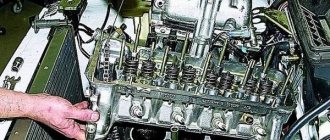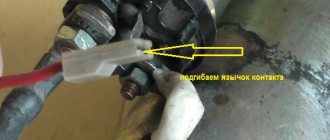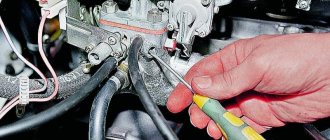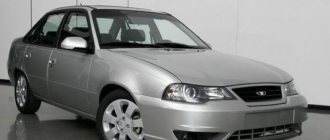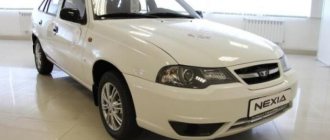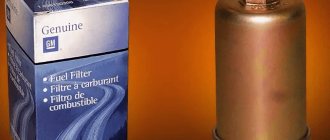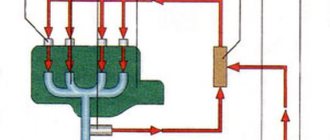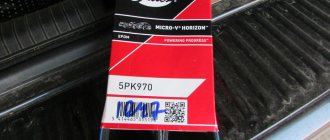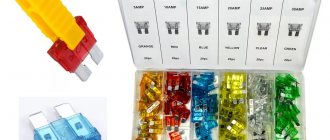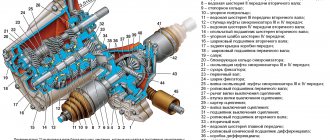The site provides access to an extensive catalog of materials, which makes repairing the Daewoo Nexia with your own hands accessible to everyone. There are various videos, photo reports, instructions and advice on maintenance, repair and operation of the Daewoo Nexia.
Information is constantly updated and multiplied, thus presenting the best alternative to the Daewoo Nexia repair manual. A regular manual contains a static set of instructions, in the best case, supplemented by several photos. In turn, the catalog of Daewoo Nexia repair materials is not limited to this, and gives you the opportunity to watch a video on how to do it yourself for free, directly ask for advice from real auto repair experts, or share your own observations, helping a fellow car owner.
And help will certainly be needed: although the Daewoo Nexia is a very good car, it still forces its owners to think about such things as replacing valves or replacing the timing belt. There are simpler tasks, like replacing a bearing or replacing a lock. And of course, changing the oil is a periodic maintenance procedure familiar to every driver.
Excursion into the history of Daewoo Nexia
Daewoo, as you know, is a South Korean company, but Daewoo Nexia also has German roots. The car was developed by the Opel concern based on the Opel Kadett, and was subsequently modernized by Daewoo. The Daewoo Nexia was once assembled in factories in South Korea, Egypt, Vietnam and Romania, but from 1996 to the present, the car has been produced only in Uzbekistan . Having survived two generations of restyling, the Daewoo Nexia has gained popularity among drivers, as evidenced by the “circulation” of cars of 500,000 copies.
Daewoo Nexia from 08 device, operation, maintenance, repair
A book from a series of multicolor illustrated manuals on how to repair cars on your own. The manual covers the design, maintenance and repair of Daewoo Nexia cars manufactured since 2008. Possible malfunctions, their causes and solutions are described in detail. Maintenance and repair operations are presented in color photographs and provided with detailed comments. The Appendices provide tools, lubricants, operating fluids, lamps, as well as tightening torques for threaded connections.
The book is intended for drivers who repair the car themselves, as well as for service station workers. The Nexia car (Nexia) of the South Korean concern Daewoo (Daewoo) was created on the basis of the German Opel Cadet car, produced from 1984 to 1992. The Korean version of the car was called Daewoo Racer. In 1994, Daewoo carried out a restyling, after which the model received the final name “Nexia”. In 1996, production of the model began in Uzbekistan (Uz Daewoo Auto JSC) and in the city of Aksai near Rostov-on-Don. Since 2000, production of the model (except for engines) has been transferred to Uzbekistan. In 2008, the car underwent restyling, during which some body panels and lighting equipment were changed, and new engines began to be installed. This manual covers the design, operation, maintenance and repair of Nexia cars produced since 2008 with a sedan body, engines of the F16D3 models (16-valve, with two camshafts - DOHC) with a displacement of 1.6 liters and A15SMS ( 8-valve, single camshaft - SOHC) with a displacement of 1.5 liters, with a manual gearbox.
REMOVAL OF THE OUTER HINGE We perform the work when replacing the hinge or its cover. We dismantle the drive (see “Removing the front wheel drives”, p. 160). When replacing the cover, clean the outside of the hinge and clamp the shaft in a vice with soft metal jaw linings. Use side cutters to cut through the clamp lock and remove the clamp. Having cut through the lock of the other clamp, we also remove it. We move the cover along the shaft. It is more convenient to knock the hinge off the shaft with an assistant. Remove a small amount of grease from the area of the retaining ring antennae and insert pliers between the antennae. Unclamping the retaining ring, use a soft metal drift to strike the end of the hinge cage with a hammer and knock down the outer hinge.
We remove the cover. We clean the shaft of grease, apply a thin layer of new grease to it and put a new cover on the shaft. If, based on the results of the initial diagnosis of the hinge (no excessive radial play, strong biting, grinding, etc.), the old hinge can be left, then remove as much as possible of the old lubricant from it (without introducing dirt), inspect the balls, separator, cage and body without taking them apart. Traces of corrosion, scuffs and dents on the tracks are not allowed - such a hinge should be replaced. We put new grease into the joint cavity and install the joint on the shaft, making sure that the retaining ring fits into the groove of the shaft. We move the cover along the shaft so that the end of the cover with a smaller diameter is located in the groove of the shaft. We put the cover on the hinge body and squeeze the cover to remove air from it. We secure the cover with new clamps.
Equipment and types of Daewoo Nexia
For a long time, Daewoo Nexia was equipped with one 1.5 engine, which changed as it became obsolete. The power of this engine was quite decent - up to 100 horsepower - with a 16-valve cylinder head. But it was quite rare, where more often there was an 8-valve engine , with which the engine produced 75 “horses”. In 2008, the engines that did not meet Euro-3 requirements were replaced by a 1.6 engine with a capacity of 109 horsepower.
Nexia has three body options :
- sedan;
- three-door hatchback;
- five door hatchback.
At the same time, on the Russian market, Daewoo Nexia was sold only in a sedan body of two trim levels: GL and GLE. The basic GL looks ascetic - a simple radio and air conditioning. The luxury GLE has a more attractive appearance - decorative caps, nameplates, painted bumpers, a sun strip on the windshield... In addition, the extended configuration is equipped with electric windows , central locking, and soft door upholstery. The installation of air conditioning and power steering is provided, but not all cars were equipped with them.
DIY repair and operation manual for Deawoo Nexia - Daewoo Nexia
Proper maintenance and repairs are very important for the safe operation and reliability of your vehicle. This manual describes effective and correct techniques for performing all necessary vehicle maintenance and repair operations. In some cases, the use of special tools and devices is required. These tools and accessories must be used strictly in accordance with the recommendations.
When carrying out work on electrical equipment associated with the possibility of a short circuit, it is necessary to disconnect the “mass” cable of the battery. After connecting the battery, it is necessary to reset the electrical clock, repeat the settings and store the frequencies of broadcast stations in the radio receiver’s memory, and also reprogram other electronic equipment of the car. The above warnings are not exhaustive. The Daewoo company cannot, of course, foresee in advance all possible variants of technological operations and dangerous situations that may arise during vehicle repair and maintenance. Therefore, before using any technique or tool other than those recommended in this manual, it is very important to ensure safety for personnel and vehicle. This manual describes maintenance and repair operations primarily for left-hand drive vehicles. On vehicles with right-hand drive, all operations are carried out similarly (in mirror image). The functions of various vehicle systems and devices do not depend on the steering control option. If there are any significant features of vehicles with different steering options, the manual provides additional information accordingly.
General repair instructions
When using a floor jack, the following rules must be observed. Place the car on a horizontal platform. Block the front or rear wheel from possible movements. Place a jack under the body support socket and lift the car. Place rigid safety supports under the car. Only then can maintenance or repairs begin.
Before carrying out any work, DISCONNECT THE BATTERY GROUND CABLE to avoid damage to the vehicle and personal injury due to a short circuit.
Use protective covers to protect the body, seats and floor mats from damage and dirt. Do not allow brake fluid or coolant to come into contact with the vehicle body as it may damage the paintwork.
Use only proper tools recommended in this manual.
Reuse of cotter pins, gaskets, O-rings, lip seals, lock washers and self-locking nuts is not permitted. When assembling the units, it is necessary to replace them with new parts. Otherwise, normal operation of the units cannot be guaranteed.
To simplify and speed up assembly of units, carefully store disassembled parts in separate groups.
Do not confuse the different mounting bolts and nuts as they vary in strength and design features depending on the installation location.
Clean parts from contamination before inspecting or installing them.
Parts of oil systems must also be cleaned and blown with compressed air to remove all contaminants.
Before installing parts, lubricate the sliding and rotating surfaces with liquid oil or grease.
If necessary, to eliminate leaks of oil or operating fluids, use sealant together with sealing gaskets.
Carefully follow the tightening torque requirements for bolts and nuts.
After completing maintenance or repairs, perform a final check to ensure that all operations have been carried out correctly and that the fault has been corrected.
The history of the appearance of the first Nexia in Russia with a brief description (sometimes it is also called “Dave”) sells through its dealers in Russia “Nexia”, which is based on the Opel Kadett, which has proven itself well in the world. In Korea, this car is known under the brand name “Cielo”. Actually, previously a Korean car under the name “Le Mans”, the car was exported as a “Daewoo Racer”, in the USA - under the pseudonym “Pontiac Le Mans”. Changes came later, when the car put on a new dress: the main frame, like the window and door openings, remained the same, but all the outer panels changed - like the VAZ-2105 in relation to the VAZ-2101. The basic design of the Nexia is the same as that of the Kadett, but has numerous improvements. Model of the same class as Moskvich-2141. True, the buyer can choose the Nexia with any of three body styles: a three- or five-door hatchback and a four-door sedan. There are plenty of hatchbacks on the Russian market. These are Tavria, Lada-Samara, Moskvich-2141, and in small quantities IZH-2126. The consumer, as it turns out, is very interested in sedans. That’s why “Dave” offers a modification with such a body.
At international exhibitions in Moscow and Frankfurt am Main, Nexia made its European debut. Almost simultaneously with the start of sales of this model in Russia, a plant in Asaka (Uzbekistan) began operating. The assembly of Daewoo minibuses has already begun in the workshops of the former enterprise for the production of tractor trailers. By the end of the year, it is planned to launch the assembly of the Nexia and the Tiko minicar, a total of six thousand units. Naturally, they will soon appear in Russia.
So what is this car?
This is a model tested on the mass consumer and will not cause any unpleasant surprises. In addition, it has an ultra-modern, dynamic and solid appearance. For a Russian motorist, Nexia is a car for every day. Easy to operate, robust and practical to use. It has a trunk volume of 0.53 m3, a very flexible engine, 13-14-inch wheels, a very small (for a car 4.5 meters long) turning circle (9.8 meters), quite acceptable ground clearance (165 mm) . Add here power steering, headlight range control, power windows, central locking, car radio with automatic antenna, separately reclining rear seat backs, remote opening of the trunk and refueling hatch, height-adjustable driver's seat. Overall, this is a modern, well-packaged car in the form in which today's drivers would like to see it. Airbag on the steering wheel (for an additional fee), 28-mm protective bars in the doors, rear door locking (anti-child), ABS in the brake drive (for an additional fee), central door locking...
“Nexia” with a three-door hatchback body looks a little “opelovato” (it is based on the design of the “Opel Kadett” and is equipped quite richly.
Among the innovations recently introduced into the design of the Nexia, one of the most important is a four-speed automatic transmission as an alternative to a five-speed manual one. It is equipped with electronic control and can operate in any of three programs that the driver chooses. One is economical, the second is high-speed and the third is winter (for driving on slippery roads). For us, such automatic transmissions are still a rarity, but perhaps, just for Russian road conditions, the three-program scheme will turn out to be very practical.
From the first minutes behind the wheel of a car, the driver feels familiar, as if it were an old friend of his.
The Russian motorist will also highly appreciate the fact that the Nexia does not cause hostility or internal rejection among mechanics, because there are still many used Cadets in the country, with which the Nexia has many interchangeable parts. Nexia, like its parent, is a front-wheel drive model with all the habits and inclinations familiar to our drivers. So you won’t have to expect any surprises from her here either. Moreover, experts claim that the wheel hub bearings are interchangeable with domestic ones: the front ones are from the VAZ-2108, the rear ones are from the ZAZ-968. We are forced to take this statement on faith, since the magazine’s mechanics have not yet had to disassemble and repair the Nexia’s hubs.
As for the tires, although their seat diameter is the same for Nexia and Moskvich (14 inches), their sizes are still different (and accordingly, the characteristics too): 185/60R14 versus 175/70R14. Here, the future owner of a Korean car can hardly count on an equivalent replacement for native tires, unless in case of despair somewhere in a remote province where the necessary imported tires cannot be found.
Of no small importance for the Russian motorist is the reliable anti-corrosion protection of the Nexia’s body. In European countries, Daewoo, for example, gives a six-year guarantee against rust-through. For our climatic conditions, one can hardly expect such high durability, but in general, the six-year period suggests that with careful care, when the owner does not expect to change cars frequently, the body will last a long time.
“Nexia” is adapted to domestic AI-92 gasoline and adapted to the habits of Russian motorists: soft, slightly flimsy in suspension, it does not give the feeling of a sharp steering wheel, has good noise insulation and an interior that is quite acceptable from all points of view (size, finish, appearance) . The build and finish quality is high, and thanks to its uncomplicated and traditional design, the Korean car can handle both self-maintenance and self-repair.
Buyers' interest in the car is already considerable today. The explanation for this is “a lot of car for a monetary unit.” The retail price of Nexia is from 15 to 17 thousand dollars, depending on the configuration. The survey shows that it is bought mostly by people for whom this car is the first new foreign car in their life, which may not be replaced in the coming years. In other words, a “long-lasting” family car for the middle-income segment of the population.
This modification of the “NGV-3” of the famous Daewoo Nexia model is notable for the fact that its engine runs on natural gas. The fuel reserve is enough for 400 kilometers. The gas is stored in an 80-liter cylinder made of composite material under a pressure of 250 atmospheres.
In conclusion, we draw your attention to the fact that Nexia is supplied to Russia only with sedan and five-door hatchback bodies as standard, with a single type of engine, but with two types of gearboxes: mechanical and hydromechanical. (Author: Mikhail Rumyantsev)
Daewoo Nexia engine 8 valves timing device, technical characteristics of Daewoo Nexia 1.5 l.
Reading time: 2 minutes
The Daewoo Nexia engine 8 valves with a volume of 1.5 liters has become one of the most popular in Daewoo Nexia in recent years. Today there are quite a few cars on the secondary market with this engine. 80 hp unit (A15 SMS, the same engine is in the Chevrolet Lanos), this is a naturally aspirated gasoline engine with distributed multipoint fuel injection with an ignition coil, which replaced the G15 MF developing 75 hp. with an unreliable distributor.
Daewoo Nexia engine design 8 valves
Engine Nexia 1.5 l. gasoline, four-stroke, four-cylinder, in-line, eight-valve, overhead camshaft. The location in the engine compartment is transverse. The operating order of the cylinders is: 1-3-4-2, counting from the auxiliary drive pulley. The power supply system is phased distributed fuel injection (Euro-3 toxicity standards). The engine has a cast iron cylinder block.
The engine, gearbox and clutch form the power unit - a single unit mounted in the engine compartment on three elastic rubber-metal supports. The right support is attached to a bracket located on the front wall of the cylinder block, and the left and rear ones are attached to the gearbox housing.
Cylinder head for Daewoo Nexia 8 cl.
The Nexia 8 valve cylinder head is cast from aluminum alloy, common to all four cylinders. The head is centered on the block with two bushings and secured with ten bolts. A sealing gasket is installed between the block and the cylinder head.
The intake and exhaust ports are located on opposite sides of the cylinder head. Valve seats and guides are pressed into the cylinder head. The valve closes under the action of a single spring. Its lower end rests on the washer, and its upper end rests on a plate held by two crackers. The crackers folded together have the shape of a truncated cone, and on their inner surface there are beads that fit into the grooves on the valve stem. The valves are driven by the camshaft. The camshaft is cast iron and rotates on five supports (bearings) in an aluminum bearing housing, which is attached to the top of the cylinder head.
Timing drive of Nexia 1.5 l engine.
The camshaft of the Nexia's 8-valve engine is driven by a toothed belt from the crankshaft. The valves are actuated by the camshaft cams through pressure levers, which rest on the hydraulic lash compensators with one shoulder, and on the valve stems with the other shoulder through guide washers. The engine has hydraulic compensators , which are self-adjusting supports for the pressure levers. Under the influence of oil filling the internal cavity of the compensator under pressure, the compensator plunger selects a gap in the valve drive. The use of hydraulic compensators in the valve drive reduces the noise of the gas distribution mechanism and also eliminates its maintenance.
If the belt breaks, the valve bends! Among other features, it can be noted that the timing belt rotates the pump (water pump). The belt is replaced every 60 thousand kilometers, the pump must be changed every 120 thousand kilometers. Please note that on the old 8-valve engine with 75 hp. The timing belt generally changes every 40 thousand kilometers.
Engine characteristics Nexia 8 valves 80 hp
- Working volume – 1498 cm3
- Number of valves – 8
- Cylinder diameter – 76.5 mm
- Piston stroke – 81.5 mm
- Timing drive - belt
- Power hp – 80 at 5600 rpm. per minute
- Torque – 123 Nm at 3200 rpm. per minute
- Maximum speed – 175 km/h
- Acceleration to the first hundred – 12.5 seconds
- Fuel type – gasoline AI-92
- Fuel consumption in the city – 8.5 liters
- Fuel consumption in the combined cycle – 8 liters
- Fuel consumption on the highway – 7.7 liters
Number of cylinders – 4
A fairly reliable and unpretentious engine, the main thing is to change the oil, timing belt, and pump on time. A completely repairable power unit. The best option for a budget car.
